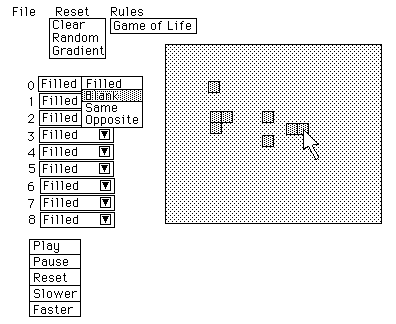
This is a diagram of the screen pattern that appears when you run the CellAutomata program.

|
By using the mouse to "click" in the field on the right, above, you can cause any
of the small squares to become "filled".
The Pull-Down menus along the middle of the left side allow you to chose the
"rules" that will be obeyed in repeatedly recalculating which squares should become
filled, which squares should become blank, which squares should remain the "same".
("same" means to remain filled if filled, to remain blank if blank)
For example, the famous "Game of Life" results from the following combination of rules:
One of the pull-down menus along the top sets the rules to be the "Game of Life"
One interesting set of rules is for squares to become blank when they have 0, 1, 2, or 3 filled neighbors, to remain the same when they have 4 filled neighbors, and to become filled when they have 5, 6, 7 or 8 filled neighbors. Try setting the field to a random pattern, using the "Reset" pull-down menu along the top row, and then watch the effect of this set of rules. In this cellular automaton, the squares are light blue the first time they become filled, become dark blue when filled for two generations in a row, and become black when filled for three or more generations in a row.
Otherwise, however, all squares only have two values, 0 (blank) and 1 (filled). Alternatively, you could count only the neighbors directly above and below, and directly to the right and left (i.e. not count diagonal neighbors) in which case the maximum sum is 16 when squares can have 0, 1, or 2 as their values. Even so, there are still more alternative choices, because you might reassign squares that now have 0 to become either 1 or 2, etc. I would like to put a really general program on line that lets the user chose how many alternative values each square should have (2, 3, 10, etc.), to decide which other squares should be counted as neighbors, and to specifiy what action should be taken for each of the (really large!) numbers of alternative sums or averages, or differences, or whatever currently exists among each square's neighbors. Please do not think that such arbitrary rules have no comprehensible relations to to the prediction of reality. Consider a cellular automaton in which each square is allowed to have any of the values 0, 1, 2, 3, 4, 5, 6, 7, 8 or 9. Then let the rules be that the values of each squares' neighbors is added up, averaged, this average compared with the current value of that square itself, and that square decreasing in value when its current value is larger than the average of its neighbors, and increasing when its current value is smaller than the average value of its neighbors. This simulates diffusion very economically.
33333333333333333333333333330In order to simulate the physical distortions of elastic materials, then each square needs to contain three independent numbers (representing positions along the X, Y and Z axes, and for the " recalculation rule" to calculate differences in these values from those of the immediate neighbor squares, to take the square root of the sums of the squares of these distances, to apply a proportionality equation which plays the role of an elastic modulus, etc. etc. Any computer program that simulates spatial variations by diffusion, attraction, repulsion, or any other interaction, will have at the core of this simulation something equivalent to a cellular automaton. For my class in Embryology, I ask the students to use the JAVA cellular automata program to explore the consequences of the following. #1) Change the settings for 0, 5 and 6 neighbors to "Blank", then click on a corner square in the playing field area to the right; and then click on "Play". #2) Describe what happens. #3) Do the patterns generated have any plane of mirror image symmetry? #4) Do all the patterns have this symmetry, or just some of them?
#5) Go to the upper row of pull down menus, and click on "Game of Life" #6) Are the flashing patterns still symmetrical?
#7) Let the patterns run for a while until they calm down, and you get mostly
#8) Do these individual small black stable patterns have any individual symmetries?
#9) Next change the setting for "4" neighbors so that it reads "same", instead of "blank".
#10) Then click on any of the squares next to one of the stable patterns: what happens?
#11) Reset all numbers, 0 through 8 to filled; wait a bit, and then set 0 and 8 to "blank".
#12) Explore the consequences of different sets of "rules",
like "Blank" for 0, 1, 2, 3. "Same" for 4, and "Filled" for 5, 6, 7 and 8.
|